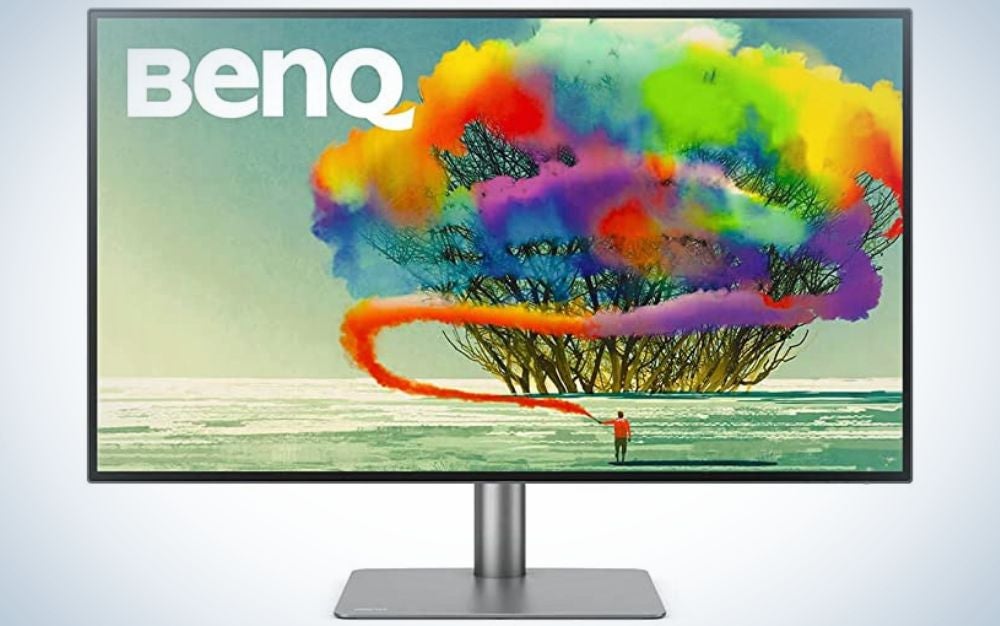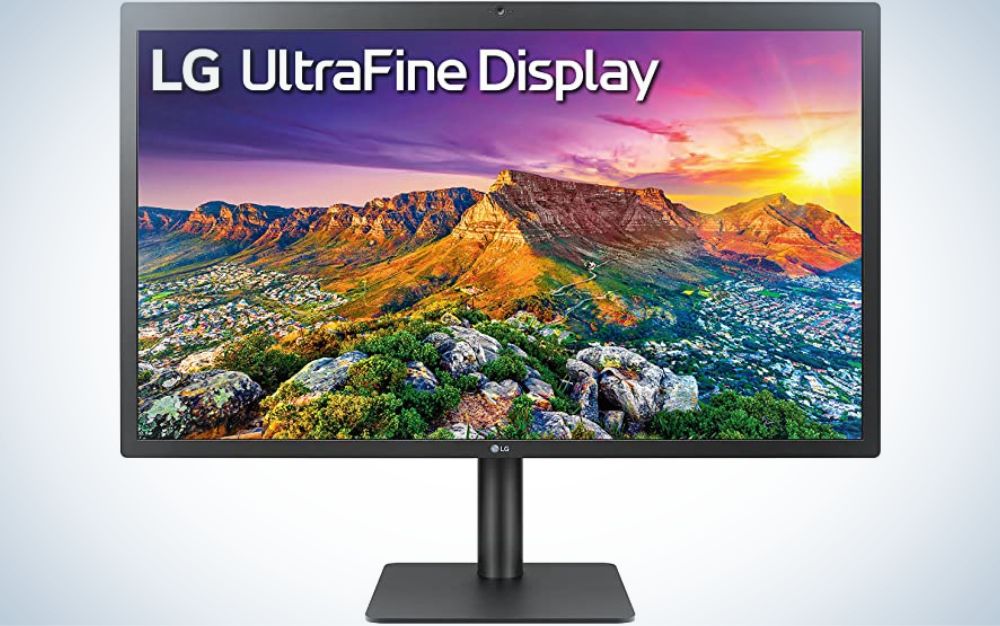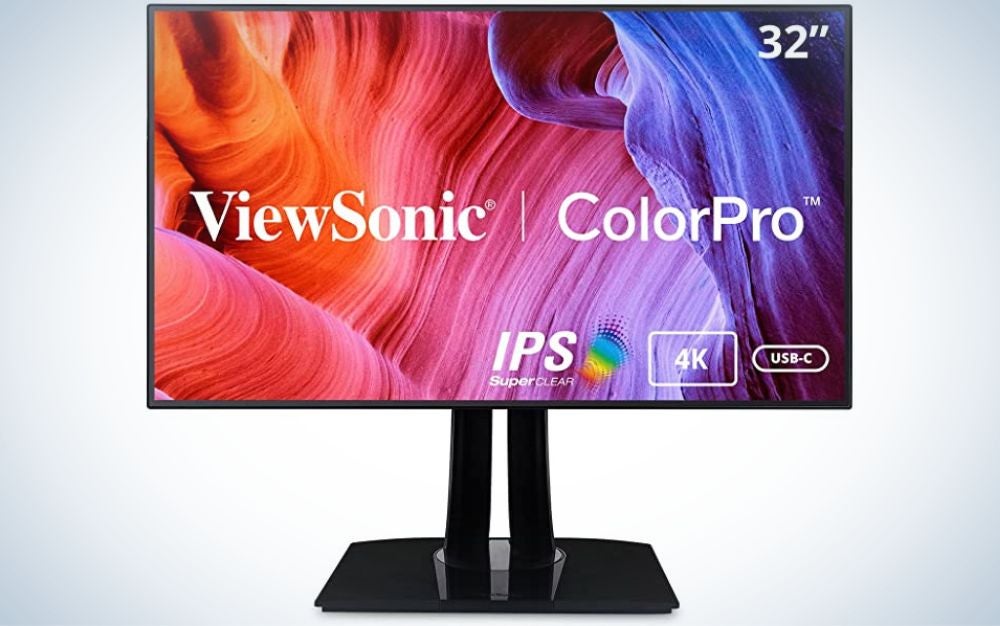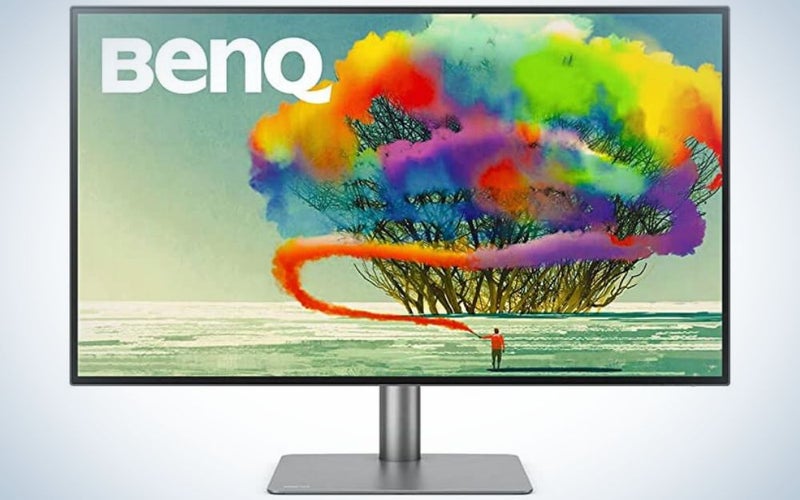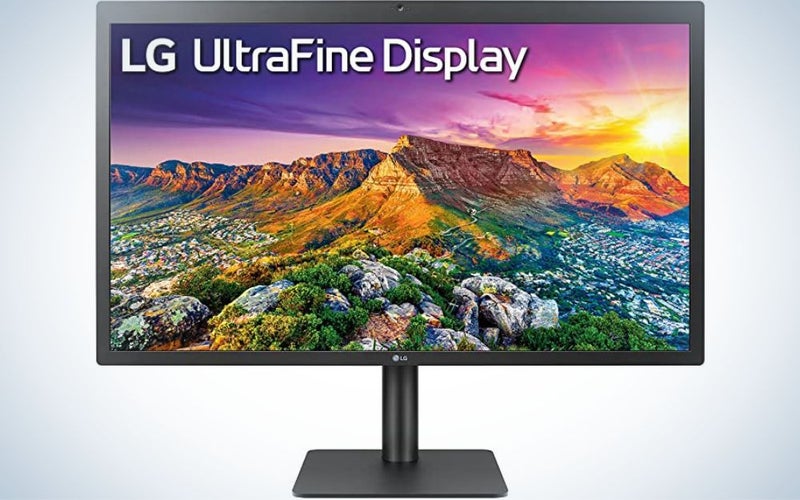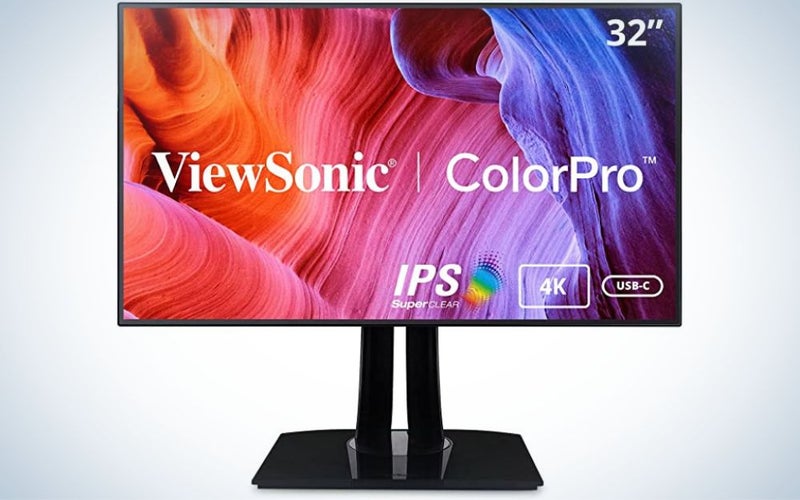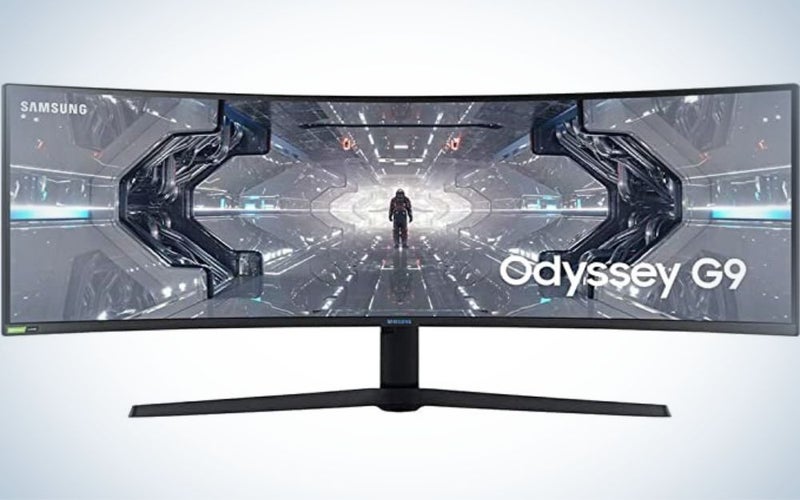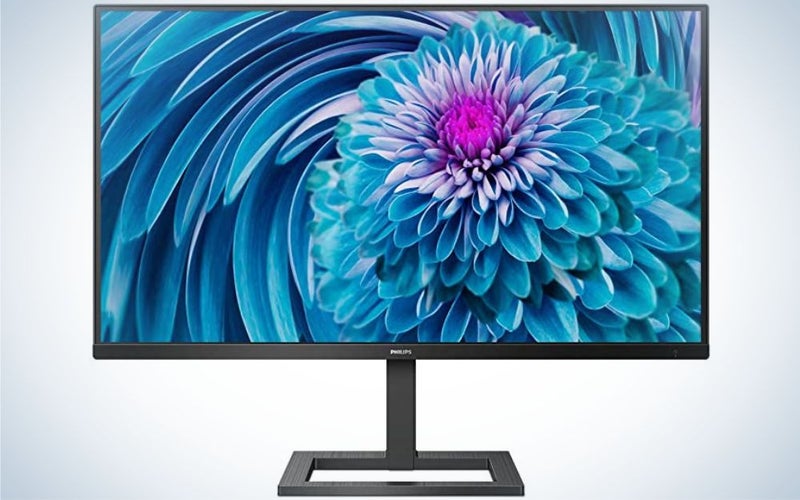
Monitors for graphic design have some very specific requirements beyond the typical displays found in homes and offices. Graphic designers frequently work in fine detail, so sharpness and clarity are critical. Text components and fine line work should be crisp and easy to see, or you’re just asking for a headache. Color accuracy is also crucial in graphic design. Displays need to accurately depict tones and offer advanced color management because inconsistencies could cost big money in professional settings. You don’t want to wrap up their design and get printed materials made only to see that the colors don’t match the customer’s branding. The best monitors for graphic design will ensure your work meets the needs of even the most demanding clients.
- Best overall: BenQ PD3220U
- Best for Mac: LG 27MD5KB-B Ultrafine 27″
- Best for graphic design and photography: ViewSonic VP3268a
- Best curved: SAMSUNG 49-inch Odyssey G9 Gaming Monitor
- Best budget: Philips 288E2E 28″ Frameless Monitor
Things to consider before buying a monitors for graphic design
As with any monitor or technical device decision, there are lots of different specs and terms thrown around. It can be very confusing to wade through what matters and what doesn’t. To simplify things, when it comes to graphic design, three features are most important: screen size, resolution, and color accuracy. Things like refresh and response rate aren’t relevant to graphic design, so you don’t need to worry about those.
Screen size
Screen size will have a big (no pun intended) impact on your workflow. While you can absolutely work in design programs on laptop screens or small external monitors, creating on a larger display can make your work more efficient and comfortable. A large monitor will allow you to see more at once, so you can scroll around less. It makes it easier to compare things when you need to because you can fit multiple canvases on a single screen. And, you won’t have to squint and crane your neck forward when working with small details.
For most graphic designers, a screen between 27 and 32 inches will be perfect. But, if you like to multitask with multiple windows open at once, or want a more immersive experience, something around 40 inches may be better. Those huge displays offer lots of screen real estate without having to worry about perfectly color matching multiple displays.
Resolution
Resolution is another essential spec to pay attention to, especially for designers and photographers. Many will say that you absolutely need a 4K monitor for graphic design, but that isn’t necessarily the case. 4K displays do provide some advantages. The detail is exceptional, which can be helpful for certain types of design work. All those pixels come in handy for displaying large versions of your work with room enough for your editing program’s tools and palettes. But, these high-res displays can also get very expensive and may be out of reach for many.
For some types of design, or someone just starting out, 4K may be overkill. Instead, a resolution of at least 2560 by 1440 will give you a good balance between quality and price. That said, if you can afford a 4K–or higher–monitor, go for it. The Apple Studio Display currently offers 5K resolution, which is nice to have if you’re flush with budget.
Color accuracy
Color accuracy is the third piece of the holy trinity for graphic design monitors. It may even be the most important for certain types of design, such as if you need to print your designs frequently. You don’t want your clients to get their flyers or business cards only for the colors to be different than what they saw in your mockups because your monitor isn’t accurate. Branding consistency is important, so it’s vital that your monitor displays accurate colors.
Part of color accuracy depends on how much of the color gamut (or range) is covered. A monitor for graphic design should have 100% coverage of sRGB and ideally 100% of the wider Adobe RGB color space. DCI-P3 is an even wider color space, primarily used in the film industry. If you see a large percentage of DCI-P3 covered, it’s likely you’re going to get solid color performance.
The other piece of color accuracy gets real nerdy. A monitor’s color accuracy is measured in Delta E (dE). The lower a monitor’s dE number, the more accurate it is. For graphic design, look for monitors with a dE of less than three.
It is also worth noting that while a quality monitor will come well-calibrated right out of the box, you will want to invest in a color calibration tool for high-end design work. The Datacolor SpyderX is a great way to ensure your screen is accurate.
Display type
Without diving deep into monitor technology, you’ll typically want to look for a monitor with IPS or in-plane switching. These displays still rely on LCD (liquid crystal display) tech, but they often offer far superior color reproduction and much wider viewing angles than their competition. This tech can help fend off typical shortcomings like monitors that get darker or introduce color shifts as you approach the edge of the screen.
Anti-reflective screens
Just like with camera lenses, reflections are bad news when it comes to monitors. They reduce contrast and have a negative overall effect on the on-screen image. Ambient lighting can also cause odd color casts on the screen, which can affect its performance. Some displays rely on anti-reflective coatings or matt surfaces in order to cut down on reflections. That’s something to consider if you work in a space with a lot of ambient light or windows. Some models include hoods that shield the screen from ambient light.
Here are our picks for the best monitors for graphic design in 2022:
Best overall: BenQ PD3220U
BenQ
Why it made the cut: With specific modes for different types of design, 95% coverage of DCI-P3, and 140 ppi, BenQ built this monitor with graphic designers in mind.
Specs:
- Screen size: 32 inches
- Resolution: 3840 x 2160 pixels
- Color gamut coverage: 95% DCI-P3 and Display P3, 100% of sRGB
- Contrast ratio: 1000:1
Pros
- Easy daisy chaining
- HDR-10 compatible
- Has built-in specialized designer modes
- 140 ppi for excellent detail
Cons
- Pricey
BenQ is one of the top brands for monitors designed for creative industries like photography and graphic design, and the PD3220U is one of its premier offerings. It boasts 4K resolution and a ppi of 140 for exceptional detail. This particular model has a 32-inch screen, which is nice and large so that you don’t have to lean in and squint to see the fine details you’re working on. And if that’s not enough screen real estate for you, it has Thunderbolt 3 compatibility that allows you to daisy chain two additional 4K monitors.
The color accuracy of this monitor is solid, with 95% of DCI-P3 and 100% of sRGB. One interesting feature of this monitor is the included Hotkey Puck G2. The puck connects to the monitor via USB and lets you quickly change color modes and adjust things like brightness and contrast. It’s easier than using the on-monitor joystick, and it’s customizable, allowing you to choose the shortcuts you need. In addition, the built-in designer modes prioritize different settings depending on the type of design work you are doing, from 3D animation to technical drawings.
While it isn’t a cheap monitor, it is feature-rich with good colors and excellent detail, making it a well-rounded option for designers.
Best for Mac: LG 27MD5KB-B Ultrafine 27″
LG
Why it made the cut: It has 99% DCI-P3 coverage for exceptional colors, high pixel density for excellent levels of detail, and it’s fully compatible with Mac OS.
Key features:
- Screen size: 27 inches
- Resolution: 5120 x 2880 pixels
- Color gamut coverage: 99% DCI-P3
- Contrast ratio: 1200:1
Pros
- High pixel density of 218 ppi
- Exceptional colors
- High resolution
- Thunderbolt 3 compatible
- Has a built-in camera and speakers
Cons
- Expensive
- No legacy ports
While most monitors will be able to function with both Mac and Windows computers, you may lose out on some features and functionality if you don’t get a display with specific Mac OS support. Many graphic designers go with Mac computers, so it’s important to have a monitor to fit their needs. And while you can, of course, drop $5,000 or more on the Apple-made monitor, that is going to be out of reach for most. Luckily, the LG 27MD5KB-B Ultrafine 27″ is a great choice for Apple-loving designers, thanks to its full Mac compatibility.
In fact, the LG 27MD5KB-B Ultrafine is so specifically designed for Mac users that it has just one input port for connecting to your computer: a USB-C Thunderbolt 3. There is no HDMI or DisplayPort. But the Thunderbolt 3 port does offer 94 watts of power, so you can charge your laptop while connected to the monitor. You also get three USB-C ports, essentially turning the monitor into a mini USB-C hub. But, if you use hard drives or other peripherals with USB 3.0 connectivity, you’ll be stuck dealing with dongles.
In terms of display quality, this monitor is stunning. The 5K resolution is truly beautiful. It has a ppi of 218, which is higher than most options out there, resulting in incredibly sharp details. Even small text is incredibly clear and crisp. The colors are also exceptional, with 99% of DCI-P3 covered. In addition, it has 500 nits of brightness, resulting in a bright screen even in a bright room.
Perhaps an odd choice for a higher-end monitor: it offers a camera, microphone, and speakers. They aren’t the best in quality, but you may appreciate the addition if you do frequent video calls with clients.
Best for graphic design and photography: ViewSonic VP3268a
ViewSonic
Why it made the cut: The ViewSonic VP3268a has a dE of less than 2 and 100% sRGB coverage, so photographers and designers can trust the display’s colors, even when dealing with picky clients.
Key features:
- Screen size: 32 inches (also available in 24 and 27 inch models)
- Resolution: 3840×2160
- Color gamut coverage: 100% sRGB
- Contrast ratio: 1300:1
Pros
- Delta E<2 for extremely accurate colors
- Large monitor size for lots of screen real estate
- VESA compatible
- Stand is very adjustable
Cons
- Adobe RGB coverage is only 77.24%
- Design is dated
The ViewSonic VP3268a has an excellent balance between features, quality, and price. It is cheaper than other 32-inch 4K monitors but still has accurate colors with 100% sRGB coverage. It is also Pantone Validated, meaning it has been tested and can reproduce the Pantone Matching System colors. The Pantone validation is mainly ideal for those who will be printing a lot, as Pantone is traditionally for prints and color swatches.
Unfortunately, it only covers 77.24% of the Adobe RGB color space. But with calibration, this monitor will produce excellent colors. It comes factory calibrated but also supports hardware calibration should you want to dial things in.
The 32-inch screen gives you lots of real estate, even if you are a multitasker. And the 139 ppi means details will be crisp and clear. There are a good number of ports, though it won’t double as a USB hub as some monitors do. But you do get access to two HDMI 2.0, one DisplayPort 1.4, and a USB-C with 90 watts of power delivery. So if you use a laptop as your main computer, you can charge it while connected to the monitor, which is a nice plus.
Best curved: SAMSUNG 49-inch Odyssey G9 Gaming Monitor
SAMSUNG
Why it made the cut: This 49-inch curved monitor provides a truly immersive experience with exceptional color accuracy and a high resolution.
Key features:
- Screen size: 49 inches
- Resolution: 5120 x 1440
- Color gamut coverage: 95% DCI-P3, 125% sRGB, 92% Adobe RGB
- Contrast ratio: 2500:1
Pros
- Extremely wide screen for multitasking
- Deep curve for immersive experience
- Excellent colors once calibrated
- Very bright
- Extremely fast refresh rate for excellent gaming
Cons
- Colors out of the box aren’t great
- Requires a large desk
Though curved screens do take some getting used to, they are ideal for ultra-wide monitors because of their improved viewing angles and reduced distortion. Samsung says the curve of this monitor matches that of the human eye. That should reduce eye strain and allow you to see more without swiveling your head around.
This 49-inch curved screen gives you loads of screen space. It’s the equivalent of two 27-inch monitors but without the distracting bezels in the middle. If you are someone who likes to have lots of windows open on one monitor, this massive display will be ideal for you.
The colors from this display are excellent, with 95% DCI-P3 coverage. However, it’s worth noting that the colors straight out of the box will not be great, coming in at around dE 3.5. Therefore, you will want to calibrate it with a calibration device. But once calibrated, the colors are truly exceptional, with a dE of just 0.56. It also has a contrast ratio of 2500:1 for rich blacks and bright whites.
Samsung designed this monitor for gamers, and as a result, it has lots of game-specific features and specs that aren’t relevant to graphic designers. The super-fast refresh rate and response time won’t make a difference in Adobe Illustrator or InDesign, but if you want to use your monitor for gaming and design, this beast of a monitor will perform well for both.
Best budget: Philips 288E2E 28″ Frameless Monitor
Philips Computer Monitors
Why it made the cut: This Philips monitor gives you excellent 4K resolution and 120% sRGB coverage at a very low price.
Key features:
- Screen size: 28 inches
- Resolution: 3840 x 2160 pixels
- Color gamut coverage: 120% sRGB, 90% DCI-P3
- Contrast ratio: 1000:1
Pros
- Very affordable
- 4K resolution
- Built-in color management
- Excellent colors
Cons
- No USB-C ports
- Not very bright
The Philips 288E2E 28″ Frameless Monitor gives you a lot of display for your money. Despite the low price, you still get 4K resolution with 157 ppi, resulting in excellent detail. Text and line work will look clear and sharp. The color accuracy is great, especially for the price. It has 120% of sRGB and 90% of DCI-P3. Calibration will give you even more accurate results, but it isn’t necessarily required.
The main downside to this monitor is that it lacks brightness. Though the colors are accurate, the lack of brightness will result in less punchy colors, especially in brighter rooms. If you like to work in a room with quite a bit of ambient light, this screen may not cut it.
The included stand only has tilt and height adjustment, but it is VESA compatible, so you can purchase a more ergonomic stand or monitor arm. Unfortunately, you don’t get an excessive number of ports in order to keep the price low, but there are two HDMI 2.0, a DisplayPort 1.2, and a headphone jack. It’s not a feature-heavy monitor, but you can’t beat 4K at this price.
FAQs
Does a graphic designer need a 4K monitor?
A graphic designer does not necessarily need a 4K monitor. While 4K will provide excellent levels of detail, a plus for design work, the cost of a 4K monitor can be extremely high. You can still produce quality designs at a lower resolution. We would recommend something with a resolution of at least 2560 by 1440.
Q: Are OLED monitors good for graphic design?
OLED monitors are good for graphic design. They offer exceptional contrast and color, which is essential for graphic design work. That said, they do get costly compared to other options. So while they are nice to have, they are not a must-have if your budget doesn’t allow it.
Q: How much does a monitor for graphic design cost?
A monitor for graphic design will cost anywhere from $250 to $6,000. The price will vary depending on aspects like resolution, size, and display type. The cost gets quite high as you get into higher resolutions and sizes.
Q: Are curved monitors good for designers?
Curved monitors are good for designers, especially when you get into large monitor sizes. This is for a few reasons. First, curved monitors actually lessen distortion. With a large flat screen, the monitor’s edges will be further away from your eyes than the center, which will produce distortion. With a curved screen, the curve puts the entirety of the monitor at roughly the same distance from your eyes. You also get a wider field of view with a curved screen because it will fall more naturally into your field of vision. All of this also means that a curved screen will be easier on your eyes than a large flat screen, which is a plus when you spend long hours staring at a screen.
Final Thoughts
A good monitor for graphic design will need three main elements: a decently large screen size, high resolution, and accurate colors. Beyond those things, the particular screen size and features you need will come down to personal preference, the type of design you do, and if you plan to use it for anything other than design.
Methodology
The writers and editors at Pop Photo have decades of extensive experience in just about every area of photography, including peripherals like monitors. While there are certainly specific features related to graphic design monitors, the needs of a graphic designer mostly overlap with those of photo and video editors. Resolution, screen size, and color accuracy are essential to both practices and were prioritized when selecting monitors. Graphic designers will have different preferences and specific needs, so we aimed to choose a variety of sizes and styles. Lastly, even though monitors can get expensive, we tried to find options that covered different budgets.
The post Best monitors for graphic design for 2022 appeared first on Popular Photography.
